January 26 - February 1, 2014: Issue 147
Figureheads – Salty Wooden Personifications of Vessels
A figurehead is a carved wooden decoration found at the prow of ships largely made between the 16th and 19th centuries. Although they may not be a huge collectors item, they do feature anywhere there is a maritime heritage and do feature in museums that wish to impart some insights into vessels and their histories. The Figurehead Hall at Marinmuseum, Karlskrona Sweden, one of Sweden’s oldest museums, is a good example of one of these. Many of the figureheads displayed there were made by sculptor Törnström, royal sculptor to the navy, who worked at the Karlskrona shipyard during the 1700s. These include the figurehead of the ship the Dristigheten. This figurehead depicts a giant warrior with shield and short sword. Legend says that the figure was so badly wounded in Vyborg gauntlet that only the head could be saved, the restored version with a three crowns crest. (1.)

The Figurehead Hall at Marinmuseum, Karlskrona Sweden
Although earlier ships had often had some form of bow ornamentation (e.g. the Viking ships of ca. A.D. 800–1100), the general practice was introduced with the galleons of the 16th century, as the figurehead as such could not come to be until ships had an actual stemhead structure on which to place it. The menacing appearance of toothy and bug-eyed figureheads on Viking ships also had the protective function of warding off evil spirits. The Egyptians placed figures of holy birds on the prow while the Phoenicians used horses representing speed. The Ancient Greeks used boars' heads to symbolise acute vision and ferocity while Roman boats often mounted a carving of a centurion representing valour in battle. In northern Europe, serpents, bulls, dolphins and dragons were customary and by the 13th Century, the swan was used representing grace and mobility. (2.)
They were used primarily as religious symbols and to express the sailors belief that the ship was a living thing. The word "stem" is supposed to have originated in the days of the glory of the Egyptian empire, when the figureheads took the form of stately lotus flowers carved on tall stems. The word was later applied to the forepart or prow of a vessel.
As with the stern ornamentation, the purpose of the figurehead was often to indicate the name of the ship in a non-literate society (albeit in a sometimes very convoluted manner); and always, in the case of naval ships, to demonstrate the wealth and might of the owner. At the height of the Baroque period, some ships boasted gigantic figureheads, weighing several tons and sometimes twinned on both sides of the bowsprit.
Many figureheads depicted their owners, a fashionable display during the peak period of clippers upon our oceans, and these could be elaborate figures carved from the one piece of wood, or a portrait installed in a rounded frame at the 'stem'.
They were also a means for identifying friends or foes, and the education of new sailors in the Royal Navy included a course in recognising the figureheads of ships on the oceans they would sail in:
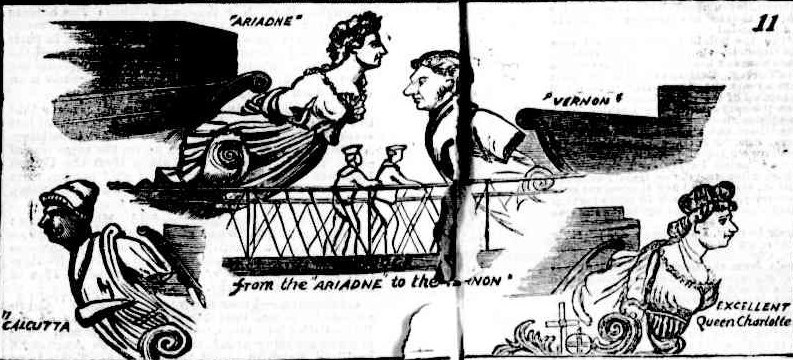
A Group OF FIGURE-HEADS. TRAINING FOR SERVICE IN THE ROYAL NAVY. (1881, September 10). Australian Town and Country Journal (NSW : 1870 - 1907), p. 24. Retrieved from http://nla.gov.au/nla.news-article70960015
The figureheads were carved by the premier artisans of their time, an example being those carved by John Haley Bellamy (1836 – 1914) a folk artist of New England, USA, known for his highly stylized carved wooden eagles and other decorative items for ships and homes. Born in Kittery, Maine in 1836, he stayed there for much of his career. Later in his life he lived and worked elsewhere in New England. Although carving was his primary means of supporting himself, he never considered himself to be an artist, and he is not known to have signed any of his pieces. His eagles are now highly desired in the collectors' market, with some selling in 2007 for over $100,000, and a large piece setting an artist-record price of $660,000 at an August 2005 auction. One of his works - the figurehead of USS Lancaster is still on display at The Mariners' Museum in Newport News, Virginia , one of the largest Maritime Museums in America.

Eagle figurehead from the USS Lancaster, circa 1880 John Haley Bellamy, carver (Amer. 1836-1914), photo by mytwocents.
In Australia the figurehead artisan was not lacking during the times when colonial shipbuilders were coming to the fore, constantly encouraged by government and press alike, and these too, prior to these adages to ships that became passé with the larger steel constructed naval ships, also had figureheads and these too indicated the name of the ship. Gordon de L. Marshal's excellent book, Ships' Figure Heads in Australia(2003), states that at least 253 figureheads were recorded as being made for vessels in New South Wales from at least 1834 when records on ships began also recording their figureheads. Two thirds of these were of women - the oldest record of one being a "woman's Bust' fitted to the schooner 'Anne' which was built at the Illarwarra in 1832. A 'Fish Figure' was placed on the sloop 'Thomas' (30ft.), built in Neutral Bay in 1933.
Garden Island is the repository of many old ship's figureheads, all with links to our Navy's history:
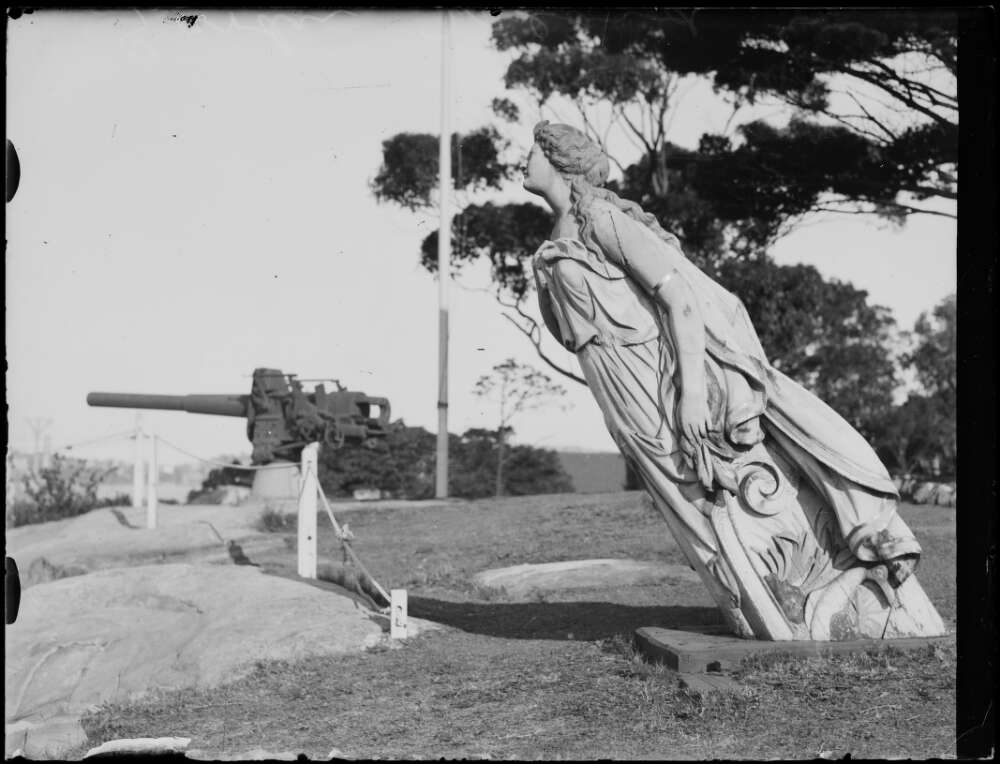
Statue of a female figurehead on Garden Island, Sydney, ca. 1930s, ourtesy National Library of Australia, nla.obj-161379982-1. Visit: History of the “Consuela” Figurehead at Garden Island by Norman C Rivett, December 1998, on Naval Historical Society of Australia website: 'Standing at the right-hand side of the main entrance to the Barracks Building of 1888 at Garden Island is the imposing figurehead from HMS Sealark known affectionately by all since 1919 as “Consuela”. A brass plate at the base states: “Figurehead of HMS Sealark late Wanderer late Consuela. Presented by Commander J. R. Patrick. RANR, on July 1, 1919.”
GARDEN ISLAND, SYDNEY, NSW. THE FIGUREHEAD FROM HMAS PENGUIN RECEIVES A COAT OF PAINT. (NAVAL HISTORICAL COLLECTION)
Not all our local figureheads were of lovely women:
OF THE STEAMER LEICHARDT.
ONE of the most important events in connection with the industrial resources of New South Wales took place, during the past month, at the Australian Steam Navigation Company's works at Pyrmont;-we refer to the launch of the steamer Leichardt, an illustration of which will be found on another page. Scarce half a century has elapsed since the first wooden vessel was constructed in Port Jackson, and now we have to record the gratifying fact that an ocean-going steamer, entirely constructed of iron, bears testimony to the enterprise of colonial capitalists and the ingenuity of colonial artizans.
To the Australian Steam Navigation Company belongs the credit of having achieved such an important result. For several years the Company have been adding to their fine fleet by the construction of steamers in Great Britain, but, notwithstanding the cheaper rate of labour there, the cost of bringing their steamers out to the colony was found very great. The successful manner in which the Telegraph, Boomerang, Clarence, and Collaroy had been lengthened, and the gun-boat Pioneer constructed, by their Chief Engineer, Mr. Macarthur, induced the Company to direct him to construct a large steamer suitable for the intercolonial trade: the result has been in every respect successful. On the 2nd of June last the keel of the Leichardt was laid, and on the 15th of October she was afloat ready to receive her machinery a striking contrast to what was achieved by getting vessels built in Glasgow ;-under that system it was found that twelve months at soonest must elapse between the time the order was despatched and the arrival of the vessel in Sydney, and when she did arrive there were generally some alterations to be made to render her suitable for the trade she was intended for.
The morning of the 15th ult. was fixed for the launch, and notwithstanding the earliness of the hour (7 a.m.) a large number of spectators, including his Excellency the Governor, Lord John Taylour, the Colonial Secretary, the Minister for Lands, and several of our principal merchants were present. The vessel, gaily decorated with flags and flowers, had been placed on the cradle of the slip, and as she lay ready to be released from her temporary thraldom and immerge on her future home, her faultless lines elicited the warm commendations of all who inspected her. A bottle of champagne, suspended from the bows by the conventional blue ribbon, waited some fair hand to perform the baptismal ceremony, and, this portion of the programme having been accomplished by Mrs. Eldred, the signal was given, and away glided the good ship down the ways, mid cheers afloat and ashore, the band of the A. S. N. Company's Volunteers playing the 'National Anthem.' The launch was completely successful, and the vessel presented a fine appearance on the water, her extreme buoyancy being a source of general remark and satisfaction, only drawing 3ft. 2in. forward and 3ft. 9in. aft.
 The Leichardt is a paddle-wheel steamer, 187ft. in length,
24ft. lin. in beam, 10ft. 6in. in depth of hold ; carrying capacity, 500 tons
builders' measurement. The figure-head is a half length figure of the
ill-fated explorer whose name she bears; she will be fitted with a pair of
high pressure steeple engines of 110 horse power, and superheating boilers
similar to those of the Diamantina, which, though nominally Rowan's patent, were
found almost useless until modified by Mr. Macarthur. They are on an entirely
new principle, and give a very large amount of steam with a nominal consumption
of fuel-the Leichardt's is expected not to exceed eight and half tons per day.
Nor has the comfort of passengers been overlooked. The cabin is what is
technically called a 'full poop', fifty feet long, with ample height from deck
to beam, and thoroughly ventilated. Berths are provided for twenty-six gentlemen
; a very commodious ladies' cabin furnishes accommodation for ten. The usual
apartments are also provided for the captain, stewards, &c. The saloon is
elegant and spacious, very chastely decorated, and fitted with every convenience
conducive to the comfort of travellers. The fore-cabins are roomy and capacious,
and contain berths for forty passengers ; and a spacious topgallant forecastle
provides quarters for the crew. Taken as a whole, the Leichardt is a credit to
the mechanical skill of the Colony; in point of workmanship .she will bear
comparison with any foreign-built vessel in the colonies; and it is asserted
that her construction here instead of in England will be a saving to the Company
of at least £2,000.
The Leichardt is a paddle-wheel steamer, 187ft. in length,
24ft. lin. in beam, 10ft. 6in. in depth of hold ; carrying capacity, 500 tons
builders' measurement. The figure-head is a half length figure of the
ill-fated explorer whose name she bears; she will be fitted with a pair of
high pressure steeple engines of 110 horse power, and superheating boilers
similar to those of the Diamantina, which, though nominally Rowan's patent, were
found almost useless until modified by Mr. Macarthur. They are on an entirely
new principle, and give a very large amount of steam with a nominal consumption
of fuel-the Leichardt's is expected not to exceed eight and half tons per day.
Nor has the comfort of passengers been overlooked. The cabin is what is
technically called a 'full poop', fifty feet long, with ample height from deck
to beam, and thoroughly ventilated. Berths are provided for twenty-six gentlemen
; a very commodious ladies' cabin furnishes accommodation for ten. The usual
apartments are also provided for the captain, stewards, &c. The saloon is
elegant and spacious, very chastely decorated, and fitted with every convenience
conducive to the comfort of travellers. The fore-cabins are roomy and capacious,
and contain berths for forty passengers ; and a spacious topgallant forecastle
provides quarters for the crew. Taken as a whole, the Leichardt is a credit to
the mechanical skill of the Colony; in point of workmanship .she will bear
comparison with any foreign-built vessel in the colonies; and it is asserted
that her construction here instead of in England will be a saving to the Company
of at least £2,000.
We trust that the construction of the Leichardt will prove a precedent for many similar enterprises. In a few-months we shall have colonial iron from the Fitzroy mines laid down in Sydney much cheaper than we can import English, and if not withstanding the expense of importing her plates, the Leichardt has been constructed more cheaply here than in England, there is no reason why we cannot mere successfully compete with foreign shipbuilders when the material is made in the Colony, and in a few years Sydney-built steamers become as well known in the Indian and Chinese seas as Clyde or London built vessels now are. Such a result may be problematical, but it is worth trying for: one step towards it is already achieved, and its final realization is at least within the range of probability.
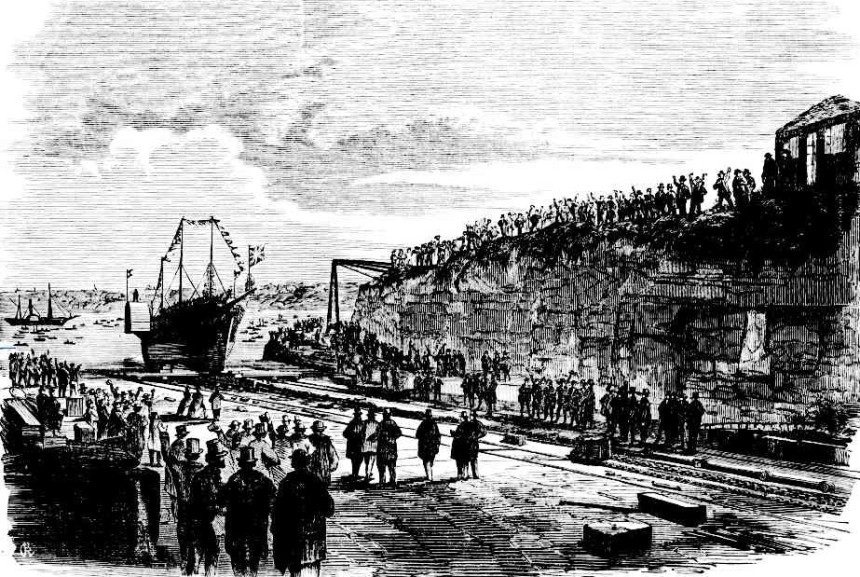
LAUNCH OF THE AUSTRALIAN STEAM NAVIGATION COMPANY'S NEW STEAMSHIP 'THE LEICHARDT'. LAUNCH OF THE STEAMER LEICHARDT. (1864, November 16). Illustrated Sydney News (NSW : 1853 - 1872), p. 5. Retrieved from http://nla.gov.au/nla.news-article63512179
COLLISION BETWEEN THE BALLINA AND SYLPHIDE. A DISASTROUS collision took place about two miles north of the North Head, Port Jackson, between the paddle steamer Ballina and the barque -Sylphide, at six o'clock a.m. on Saturday, the 16th June. The barque, which was owned in Melbourne, was on a voyage from Portland to Sydney, in ballast, and at the time of the collision was heading N.N.W., in order to drop down into the port with the flood tide. The steamer had been sighted some time previously, and she stood on to cross the course of the barque. The master of the latter did what he could to attract the steamer's attention, but unavailingly. The Ballina struck the barque's side, her figure-head going right through about seven or eight feet into the barque's deck abaft the starboard fore-rigging, and down to the water's edge. The barque at once commenced to sink, and Captain Pie, with his officers and all hands, got on board the steamer, having first released one man who was jammed by the collision, and shortly afterwards the barque sank. At an inquiry subsequently held at the Marine Board office, the Board decided that the collision had been caused by the Ballina committing a breach of the 15th article of the steering and sailing rules, and that it was brought about by the insufficient look-out on that vessel.
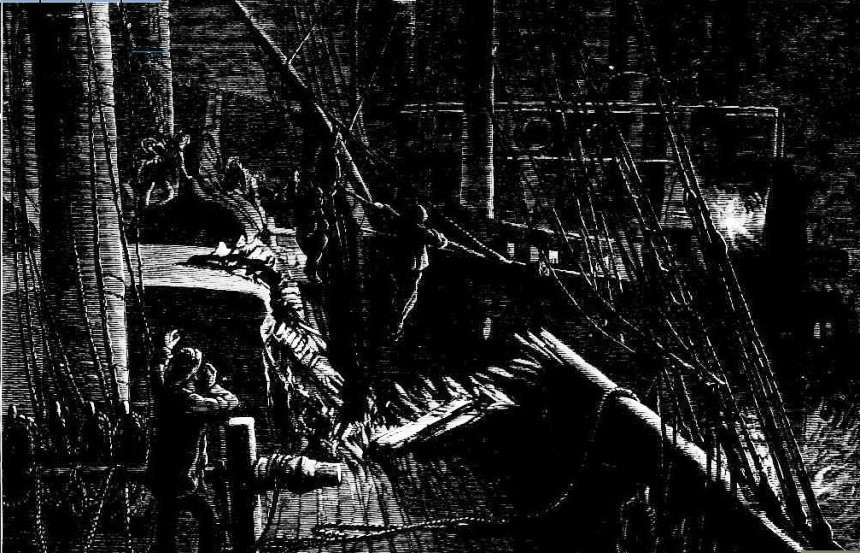
COLLISION BETWEEN THE BALLINA AND SYLPHIDE. (1877, July 21). Illustrated Sydney News (NSW : 1853 - 1872), p. 9. Retrieved from http://nla.gov.au/nla.news-article63334443
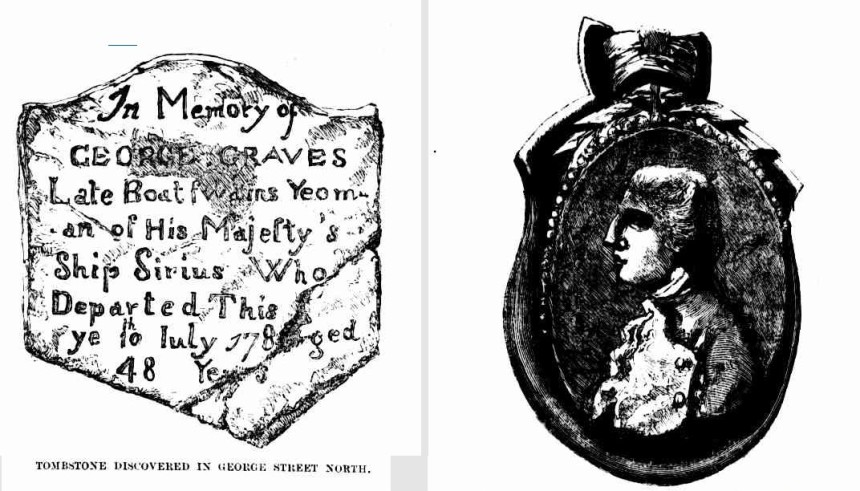
TOMBSTONE DISCOVERED IN GEORGE STREET NORTH. FIGURE-HEAD OF THE H.M.S. '' ENDEAVOUR." RELICS OF THE EARLY HISTORY OF NEW SOUTH WALES. RELICS OF THE EARLY HISTORY OF NEW SOUTH WALES. (1881, May 14). Illustrated Sydney News (NSW : 1853 - 1872), p. 9. Retrieved from http://nla.gov.au/nla.news-article64974306
The other ‘social’ aspect of the term ‘figurehead’ – is of course applied to someone who holds de jure an important (often supremely powerful) title or office. When this term was in more frequent use, like these sculptures for vessels, it had good and, in Australia, pun usage:
The gentlemen who represent the majesty of England in its constitutionally governed possessions are, it has been said, mere figure-heads on the ship of State, ornamental perhaps, but otherwise serving no demonstratively useful function. That this theory is founded on an essentially erroneous conception of the responsibilities which the person in question involves, has been proved on numerous occasions, both in New South Wales and in the sister colonies. But perhaps no more striking illustration of its incorrectness could be cited than that furnished by the career of the distinguished nobleman recently .. amongst us from Victoria, and whose likeness we present to our readers this week. In Queensland, in New Zealand, and later still in Victoria, Lord Normanby, by the wisdom and tact which he has displayed when called upon to hold the balances of parties with an impartial hand, has established a title to be regarded in a far different sense than that which courtesy implies as "a pillar of the empire." A Distinguished Visitor. (1881, September 17). Australian Town and Country Journal (NSW : 1870 - 1907), p. 17. Retrieved from http://nla.gov.au/nla.news-article70960311
ADMIRAL FIGARO—She rolls a bit and works heavily, Mao. .
COMMANDER MAO—Yes, though she is a sound ship and the weather bids fair. Her figureheads gone crank and she gets too much down by the bows.
ADMIRAL FIGARO.—Send men for'ard to clear away the gear that's foul. We'll soon fix others to suit. No title. (1888, August 25). Queensland Figaro and Punch (Brisbane, Qld. : 1885 - 1889), p. 1. Retrieved from http://nla.gov.au/nla.news-article84131630
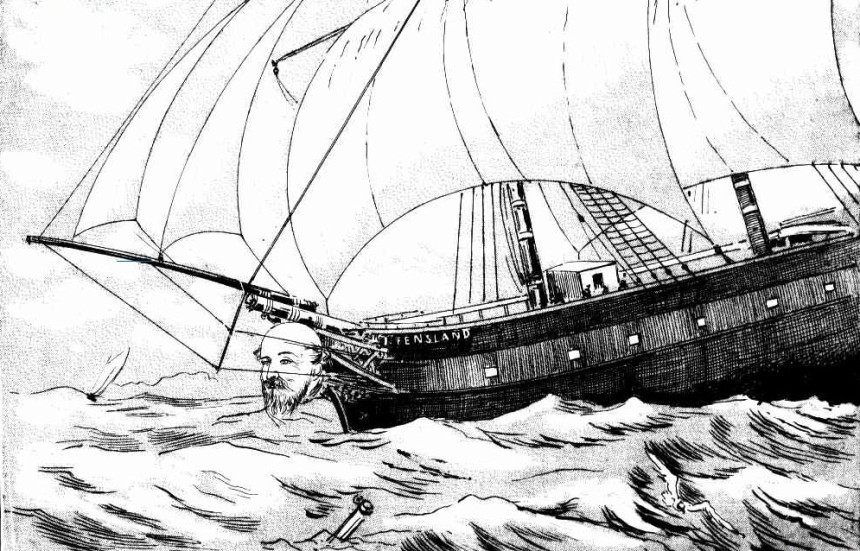
We don’t have a hall dedicated to past figureheads here in Australia, we do, however, still have very skilled people who make these and ways of working out who did this kind of art when ships were being built here that did require figureheads:
To Ship Builders, Ship Owners, &c.THE UNDERSIGNED begs to inform the above in addition to his Manufactory, he has engaged a first rate Artist, as a Figure-head, and Ships' Carver, who he can confidently recommend, as being a proficient in the art of Figure-head, Trail-bard, Stern, and all descriptions of Naval and Architectural Carving, being employed in the first manufactories of London and Greenock. Specimens of the above are in progress and ready for inspection. The Royal Arms carved and emblazoned. Figureheads and Ships Carving, repaired and made perfect. Ships Cabins ornamental or plain fitted up in the first style.-JAMES EWEN, Manufactory, Globe-street, opposite the Queen's Wharf. Advertising. (1840, March 9). The Sydney Monitor and Commercial Advertiser (NSW : 1838 - 1841), p. 2 Edition: MORNING. Retrieved from http://nla.gov.au/nla.news-article32167450
SHIP LAUNCHES.-On Thursday morning a large concourse of our respectable citizens - merchants, ship-owners, und their families-assembled in and around the extensive ship building yards of Mr. Watson, Battery Point, to witness the launch of two vessels. They were gaily decorated with flags of all nations, and stages and platforms were erected for the convenience of the spectators. Soon after eight o'clock, a fine vessel, 200 tons builders' measurement, built for Mr. Johnson, New Wharf, for the cattle trade between Port Albert and New Zealand, went off the stocks majestically, on the stays being struck away, amidst the hearty cheers of the vast number assembled. She was named by Miss James "The Fair Tasmanian" and her figure-head reflects much credit on the carver, Mr. Duke, the more so as we understand this to be the first display of his skill in this art. In little more than half an hour afterwards, a splendid schooner, built for Messrs Smith and Maxwell, to be employed in the Port Phillip trade, was liberated from her fastenings. This, also, was a magnificent launch, mid the cheers of the spectators were loud and protracted, welcoming her to the deep with many an aspiration that she may be prosperous and reward her enterprising owners. She was named by Miss Sadler, as she glided slowly and gracefully down the slips, " The Circassian " . LOCAL. (1848, January 22). The Courier (Hobart, Tas. : 1840 - 1859), p. 2. Retrieved from http://nla.gov.au/nla.news-article2970010
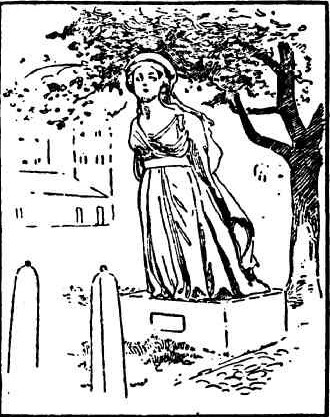
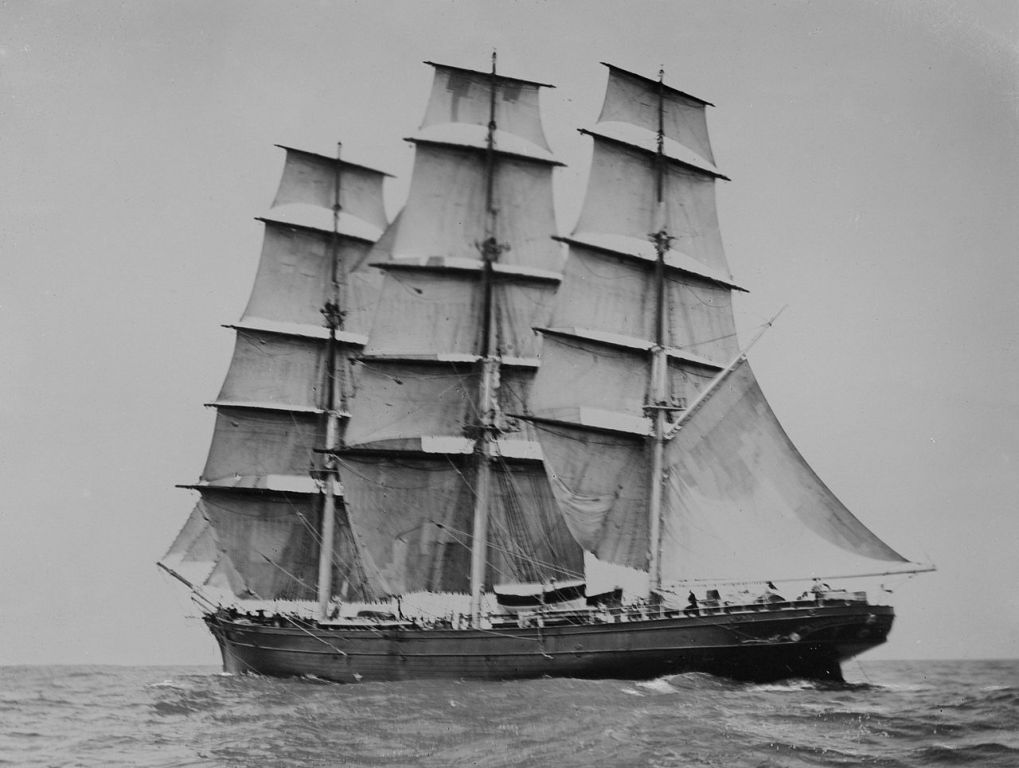
Cutty Sark with sails set. Photograph taken at sea by Captain Woodget with a camera balanced on two of the ship's boats lashed together. Before 1916, courtesy State Library of Victoria, Allan C. Green collection of glass negatives. Image No.: H91.250.264
Ladies with Salty Pasts; Sea Spray and Superstitions - By a Correspondent
R. M.S. Aorangi is being refitted in Sydney after her war service. Soon she will be a sleek and shining ship once again, ready to sail the seven seas. But though she will bring romance to many travel minded Australians, she herself, likethc rest oí the present-day ships,will lack one romantic attribute. She will have no guardian figurehead.
Figureheads have decorated the stems of vessels since the earliest days, their implied duties combining the conciliation of the sea gods and the terrifying of enemies.
The word "stem" is supposed to have originated in the days of the glory of the Egyptian empire, when the figureheads took the form of stately lotus flowers carved on tall stems. The word was later applied to the forepart or prow of a vessel.
Fashions in figureheads changed many times during the centuries they were in vogue. Sometimes they were merely effigies of princes or politicians. In the reign of Henry VIII., the lion became the usual figurehead for English ships. A little later, figureheads had become more ornate, and "Sovereign of the Seas," the most famous fighting ship of 1637, carried an ornate figurehead of King Charles I, trampling on seven enemy kings, against a somewhat incongruous background of cupids and representations of the Virtues. The rich and rare decoration on this ship had such a hold on popular fancy that even Cromwell was unable to enforce his decree that all ships of the navy were to be painted "a sombre black." "The Sovereign of the Seas" retained her glory, and in battles against the Dutch she was afterwards nicknamed by them the "English Golden Devil.'.'
FIGUREHEADS were regarded by the crew with a mixture of awe and affection, and a good deal of superstition thrown in. In comparatively modern times, a ship which generally called at Sydney was ordered on this particular voyage to sail from London to Brisbane. When nearing Sydney Head the ship ran into a series of headwinds. Old shellbacks in the crew blindfolded the figurehead until they were safely past their usual port.
A frequent saying among yachts-men and other whose talk is of the sea describes a craft as "sailing as sweetly as a witch." This phrase dates back to the famous "Cutty Sark," champion English tea clipper of all time, which, carried as a figurehead the form of Nannie the witch. Nannie was the witch in Robert Burns' poem, "Tam o' Shanter," and the "cutty sark" the witch's own short chemise.
Her cutty sark, o' Paisley harn,
That while a lassie she had worn,
In longitude tho' sorely scanty,
It was her best, and she was vauntie. .
Nannie, in her short chemise and with her flying locks, guided and guarded the "Cutty Sark" through a long and romantic career. The witch lost an outstretched arm during a storm in the Roaring 40's, but she never lost her charm. Even when she was sold to the Portuguese in 1805 and rechristened "Ferreira," her new countrymen gave her the affectionate nickname of "Pequina Camisola." But Nannie the witch liked her English connections, and in 1938 the "CuttySark" was resold to the British, and was taken to London River to join H.M.S. "Worcester" as a training ship for officers of the British Merchant Navy. The "Cutty Sark" made her last commercial voyage in 1914.
Many of the figureheads had their arms outstretched, like Nannie the witch. Very often they were detachable, and were unscrewed and placed in safety aboard ship as soon as the vessel had cleared port. Figureheads were very often of considerable value, as well as objects of affection and superstition to the captain and the crew. When gales arose their safety was of as much concern to the master as anything else aboard his ship.
Towards the end of last century, when sailing ships were still plying many regular routes, their insurance policies were substantially the same as those carried nowadays by steamships. The main differences were differences of terms. In the clause referring to "jettison," for instance, the word "sails" was included among the items that it might be necessary to cast away in a storm.
On one occasion, during a violent gale off Bahia, South America, a barque was swept on to a reef. The master, whose ship was comprehensively insured in London, was able to claim compensation on a number of different counts. He jettisoned part of the cargo and some of the rigging and spars, in an attempt to refloat the barque. He was forced to use some of the sail to plug leaks in the hull (which damage was covered by a special clause), and during the storm the carved figurehead, a golden-haired mermaid, was snapped off at the waist. When repairs were finished, the barque set sail again with a brand-new mermaid, for the master, aware of the seamen's sentimental attachment to the figure-head, had protected her by insurance and been able lo replace her.
There was a more or less fixed price for figureheads. A sloop or frigate could purchase one, for,£3 to £6. A ship carrying 80guns would be expected to pay £21; and a 100-gun -ship would have-to –pay as much as £50.
Old sailors had a fixed superstition that women were unlucky to ships, but in spite of that conviction, the majority of figureheads were women, representing Venus, nymphs and amazons, queens and heroines, or sometimes, less romantically but more tactfully, the plump Victorian wife of the master. Carvers of figureheads did a good trade, for nearly every ship had its mascot.
"Punch" once published a rhyme about a carver who showed what ingenuity could do when circumstances appeared against him.
There was an ancient carver,
And he carved of a saint; .
But the parson wouldn't have it,
So he took a pot of paint
And he changed his holy raiment
To a dashing soldier rig,'
And said it was a figurehead,
And sold it to a brig.
Perhaps this saint-turned-soldier visited Australia on one of the clippers. At any rate, a dashing sailor toured Australian waters on the "Champion of the Seas." The sailor was dressed in what was known then as "No. 1 Rig," namely, a blue jacket, tarpaulin hat, checked shirt and white trousers, with a shiny belt and a brass buckle.
Another famous ship with a famous figurehead was The American clipper "Flying Cloud," which carried an angel blowing a trumpet. "Flying Cloud" had a great run of 374 nautical miles in 24 hours to her credit-a run exceeded only by a handful of clippers, notably the Boston clipper "Lightning," which put up the all-time record clipper run,of 436 miles. In "Lightning's" first voyoge to Australia she was commanded by the famous "Bully"Hayes, with "Bully" Bragg as mate. “Lightning" and "Champion of the Seas" both carried troops to India during the Mutiny. "Lightning" was burnt at Geelong while loading wool in 1860.
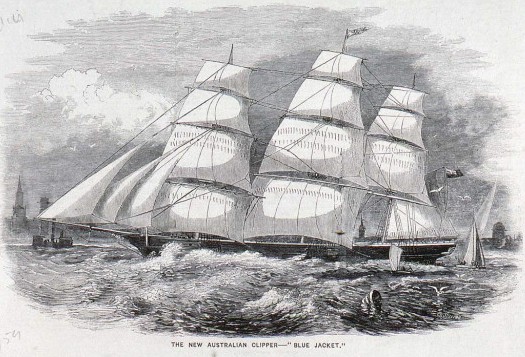 A GOOD many of the other famous chips came to a bad end,
too-in spite of the watchful care of their figureheads. To the proud ship
"Nightingale" came an acuminous fate. Her lovely figurehead was a carving of
Jenny Lind, the singer known as "The Swedish Nightingale." But the beauty of the
ringer and her faithful likeness in the figurehead could not save the ship from
descending to the depths of infamy. The "Nightingale" became a slave
trader.
A GOOD many of the other famous chips came to a bad end,
too-in spite of the watchful care of their figureheads. To the proud ship
"Nightingale" came an acuminous fate. Her lovely figurehead was a carving of
Jenny Lind, the singer known as "The Swedish Nightingale." But the beauty of the
ringer and her faithful likeness in the figurehead could not save the ship from
descending to the depths of infamy. The "Nightingale" became a slave
trader.
"Blue Jacket" was another of the famous sailing shins to come to an inglorious end. She was abandoned-on fire off the Falkland Islands in 1869-the same year that fire destroyed "Lightning." Two years after the loss of "Blue Jacket," her figurehead was washed ashore near Fremantle. It was the waist-length figure of a sailor in old-time costume, including a braid belt and large, square buckle and a cutlass hilt at the side. On either side of the figurehead was a scroll carrying the legend, "Keep a sharp look out." painted, was carried by the ship "Waterloo," launched in 1810.The figurehead remained on the ship when it became the "Belleronlion"-the ship which carried Napoleon to exile at Elba.
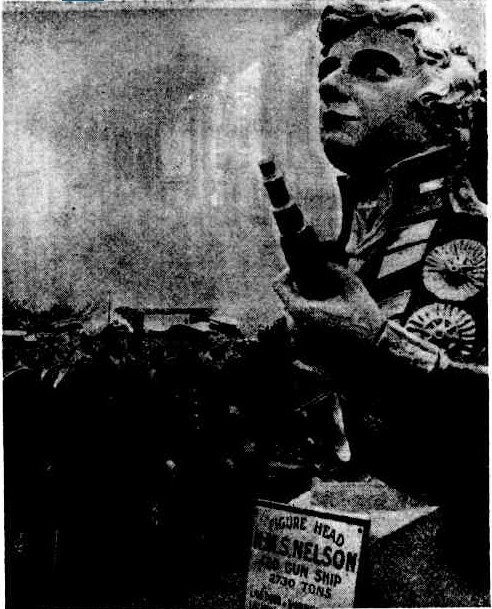
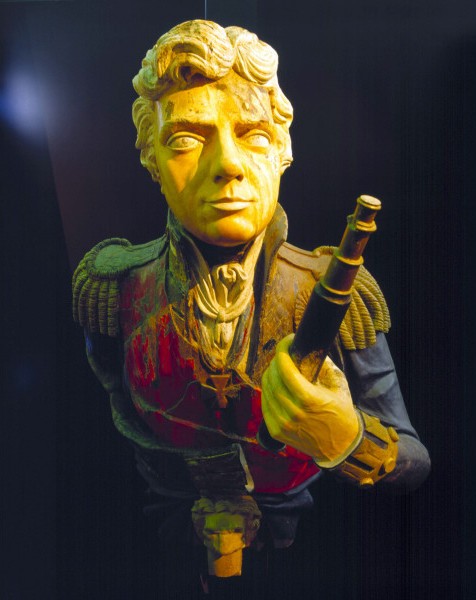 DUKE, "ABOARD" H.M.A.S.
RUSHCUTTER. With the old figurehead of
H.M.S. Nelson looking on, the Duke of Gloucester inspects a guard of honour of
R.A.N. ratings aboard" H.M.A.S. Rushcutter. Lieut.-Commander H. G.
K. Melville,
R.A.N., who commanded the guard, is with him. DUKE, "ABOARD" H.M.A.S.
RUSHCUTTER. (1945, May 30). The Sydney Morning Herald (NSW : 1842
- 1954), p. 4. Retrieved from http://nla.gov.au/nla.news-article27936233
DUKE, "ABOARD" H.M.A.S.
RUSHCUTTER. With the old figurehead of
H.M.S. Nelson looking on, the Duke of Gloucester inspects a guard of honour of
R.A.N. ratings aboard" H.M.A.S. Rushcutter. Lieut.-Commander H. G.
K. Melville,
R.A.N., who commanded the guard, is with him. DUKE, "ABOARD" H.M.A.S.
RUSHCUTTER. (1945, May 30). The Sydney Morning Herald (NSW : 1842
- 1954), p. 4. Retrieved from http://nla.gov.au/nla.news-article27936233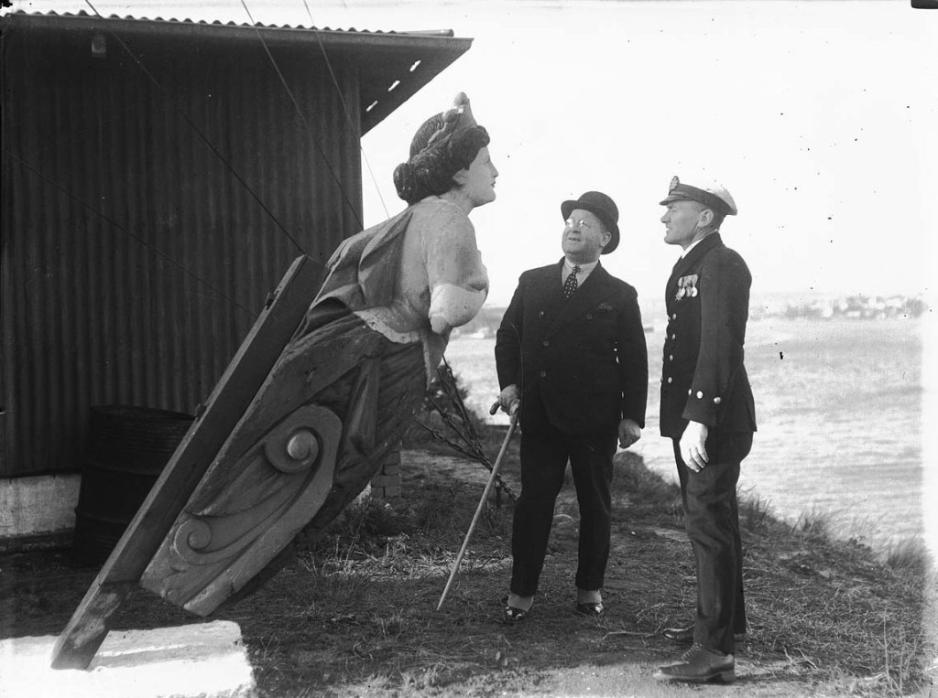
Sir Robert Archdale Parkhill inspects a ship's figurehead at Snapper Island, Sydney, ANMM IMage No: 24971, courtesy Australian National Mariitme Museum.
In trying to work out whom this lady may be we came across the legends of Gwrtheyrn (also known as Vortigern) a 5th-century king of the Britons. Some claim he was involved in incest but most scholars ascribe this to religious control agendas during that time period trying to portray him as an inept and evil king in efforts to usurp him or because he was associated, in legends, with the magi (Druids) and a young Merlin of King Arthur legends:
Then Gwrtheyrn fled again to the castle that bore his name near the river Teifi. Once more the implacable Germanus went after him, and fasted and prayed against him for three days and as many nights. And on the fourth night fire fell from heaven and consumed the wicked king, with his wives and all his followers. " Hie est finis Guorthegirni, ut in Libro beati Germani repperi. Alii autem aliter dixerunt." The author proceeds to say that this differs from the current tradition that represents Gwrtheyrn as wandering about the country, scorned by all, till he died of a broken heart. Extract from: THE LIVES OF THE BRITISH SAINTS- THE SAINTS OF WALES AND CORNWALL AND SUCH IRISH SAINTS AS HAVE DEDICATIONS IN BRITAIN By S. BARING-GOULD, M.A., AND JOHN FISHER, B.D. IN FOUR VOLUMES. VOL. III. LONDON : The Honourable Society of Cymmrodorion NEW STONE BUILDINGS, 64, CHANCERY LANE 1911
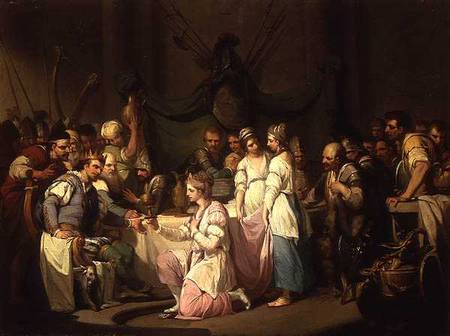 Gwrtheyrn's existence is considered
likely, though information about him is shrouded in legend. He may have been the
"superbus tyrannus" said to have invited Hengist and Horsa to aid him in
fighting the Picts and the Scots. But they revolted, killing his son in the
process and adding Sussex and Essex to their own kingdom. It is said that he
took refuge in north Wales, and that his grave is in Dyfed or the Llŷn
Peninsula. He is cited at the head of the genealogy of the early Kings of
Powys.
Gwrtheyrn's existence is considered
likely, though information about him is shrouded in legend. He may have been the
"superbus tyrannus" said to have invited Hengist and Horsa to aid him in
fighting the Picts and the Scots. But they revolted, killing his son in the
process and adding Sussex and Essex to their own kingdom. It is said that he
took refuge in north Wales, and that his grave is in Dyfed or the Llŷn
Peninsula. He is cited at the head of the genealogy of the early Kings of
Powys.
The First Meeting of Vortigern and Rowena painted by William Hamilton(1751–1801)
The story of Vortigern adopted its best-known form in the Historia Regum Britanniae of Geoffrey of Monmouth. Geoffrey states that Vortigern was the successor to Constans, the son of the usurping emperor Constantine III. Further, Vortigern used Constans as a puppet king and ruled the nation through him until he finally managed to kill him through the use of insurgent Picts. Geoffrey is also the first to mention Hengest de Cantia Regnum and the name of Hengest's daughter, who seduces Vortigern to marry her, after which his sons rebel, as a certain Ronwen recorded Rowena, also called Renwein, neither of which is a Germanic name. Like the Historia Brittonum, Geoffrey adds that Vortigern was succeeded briefly by his son Vortimer, only to take the throne again when Vortimer is killed.
So was this figurehead of the famed Rowena ? - time will tell...we hope.
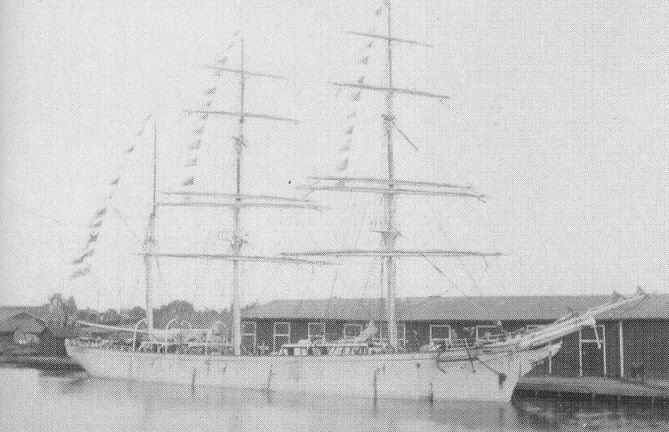 The Welsh barque Gwrtheyrn Castle arrived at Mauritius on July
29th, after a passage of 60 days from Sydney. THE
GWRTHEYRN CASTLE. (1897, September 10). Newcastle Morning Herald
& Miners' Advocate (NSW : 1876 - 1954) , p. 4. Retrieved from http://nla.gov.au/nla.news-article136278672
The Welsh barque Gwrtheyrn Castle arrived at Mauritius on July
29th, after a passage of 60 days from Sydney. THE
GWRTHEYRN CASTLE. (1897, September 10). Newcastle Morning Herald
& Miners' Advocate (NSW : 1876 - 1954) , p. 4. Retrieved from http://nla.gov.au/nla.news-article136278672
The people of this port naturally feel elated when a vessel larger than the ordinary traders arrives here. The iron-laden ship Gwrtheyrn Castle is one of these, and in order to make her advent a kind of local red-letter day the north side residents gave a public dinner to her captain, Robert Davies. This took place last Friday evening, at the Terminus Hotel, and a very successful affair it turned out to be. the viands were of excellent quality, and the speeches above the average for interest and merit. Messrs. Johnston and Dunn, speaking on behalf of the local industries, alluded in very hopeful terms to the future of this as a sugar-producing district. They estimated that this year fully £20,000 would be realised for manufactured sugar. Mr. Dunn, who is both a Maryborough and Bundaberg planter, maintained that the soil and climate were far more adapt- able here than in the sister district, the land being of much greater extent and of a superior quality. All that was needed was capital to enable them to go largely into the industry, and there could be no fear as to the result. The mills are now turning out fifty tons of sugar per week, of really excellent quality. Speeches of this kind coming from practical men are most instructive, and supply a good deal of information. Bundaberg. (1879, December 13). The Brisbane Courier (Qld. : 1864 - 1933), p. 6. Retrieved from http://nla.gov.au/nla.news-article886350
References:
1. Dristigheten (1785). (2013, September 20). Wikipedia. Retrieved 03:58, January 15, 2014 from / / sv.wikipedia.org / w / index.php? Title = Dristigheten_ (1785) & oldid = 23,806,881th
2. Figurehead (object). (2013, December 26). In Wikipedia, The Free Encyclopedia. Retrieved from http://en.wikipedia.org/w/index.php?title=Figurehead_(object)&oldid=587776253
National Library of Australia - TROVE
|
|
Researched by A J Guesdon. Copyright Pittwater Online News, 2013. All Rights Reserved.